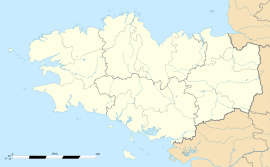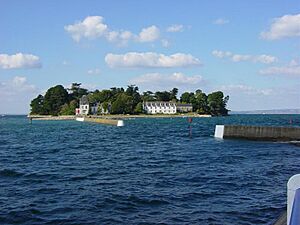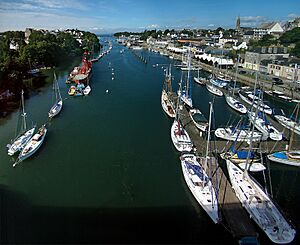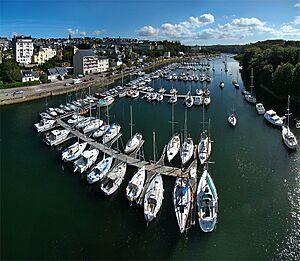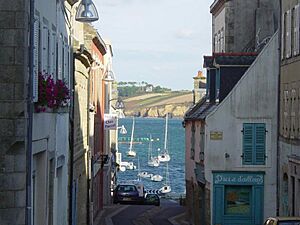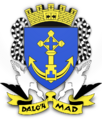Douarnenez facts for kids
Quick facts for kids
Douarnenez
|
||
|---|---|---|
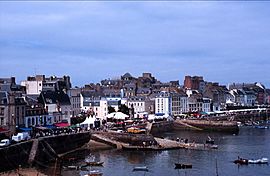
Seafront of Douarnenez
|
||
|
||
| Country | France | |
| Region | Brittany | |
| Department | Finistère | |
| Arrondissement | Quimper | |
| Canton | Douarnenez | |
| Intercommunality | Douarnenez Communauté | |
| Area
1
|
24.94 km2 (9.63 sq mi) | |
| Population
(2021)
|
14,163 | |
| • Density | 567.88/km2 (1,470.8/sq mi) | |
| Time zone | UTC+01:00 (CET) | |
| • Summer (DST) | UTC+02:00 (CEST) | |
| INSEE/Postal code |
29046 /29100
|
|
| Elevation | 0–85 m (0–279 ft) | |
| 1 French Land Register data, which excludes lakes, ponds, glaciers > 1 km2 (0.386 sq mi or 247 acres) and river estuaries. | ||
Douarnenez (Breton pronunciation: [duarˈnẽːnɛs], French: [dwaʁnəne]) is a town in France. Its name means "land of the island." It is located in the Finistère area of Brittany, in northwestern France.
The town sits at the mouth of the Pouldavid River. This is an estuary (where a river meets the sea) on the southern shore of Douarnenez Bay. It is about 25 kilometres (16 mi) northwest of Quimper. In 2008, about 15,066 people lived here. The number of people has gone down since the mid-1900s. This is because fewer jobs are available in the fishing industry.
Even so, Douarnenez still has factories that can fish like sardines and mackerel. The town was once very famous for sardine fishing. Today, it is also a growing place for tourists. Many people visit each year because of its nice location and warm weather. They also enjoy its marinas, a museum about the sea, boat races, and sandy beaches.
You can walk to Tristan Island from Douarnenez when the tide is low. This island is part of the old legend of Tristan and Iseult. This story comes from the time of King Arthur.
Contents
History of Douarnenez
The old city of Ys from Breton stories is thought to be under Douarnenez Bay. The port is also linked to the King Arthur story of Tristan. Tristan was the lover of Iseult, and Tristan Island is named after him. The island was first called St Tutuarn Island. This was after a church was built there in the 1100s. Douarnenez has several churches from the 1500s and 1600s. These include the Church of Ploaré, which has a Gothic tower.
How the Town Grew
The written history of Douarnenez starts around 1118. At that time, a bishop named Robert de Locuvan gave Tristan Island and its lands to a monastery. Because of this, a small church was built on the island. In the 1300s, the island became known as Tristan.
The small village that grew up at today's Port of Rosmeur was part of a larger area called Ploaré. It became its own town in 1790. In 1945, Douarnenez grew bigger. It added Ploaré, Pouldavid, and Tréboul to its area.
A Famous Fishing Port
Douarnenez has been a fishing port since ancient Roman times. Archeologists have found proof that fish were salted along the cliffs of Plomarc'h. In the late 1700s, sardines became very important for the town's economy. The fishing industry grew around catching and processing sardines.
By the early 1900s, there was a lot of fishing and canning happening at the port. In the 1920s, the women who worked in the factories, called Penn Sardin, went on strike. They wanted better working conditions. This was a big reason why Douarnenez became one of the first towns in France to support workers' rights. Today, fish canning still happens. However, most of the fish now come from other ports. Douarnenez is still a place where boats are built and repaired.
Railways and Travel
Douarnenez became more successful and grew a lot because of railways. These train lines were built in the late 1800s. They helped people and goods travel to and from the port. The main train service went to Quimper and started in 1884.
By the mid-1900s, more people had cars. So, passenger trains stopped running in 1972. Trains still carried goods until the railway closed in 1988. The old train line is now an 18 km (11 mi) path for cycling and walking. It's a great way to see the countryside.
There was also a smaller train line called the Youtar. It went from Douarnenez to Audierne. It opened in 1894 but closed in 1936 during a tough economic time. It reopened during the Second World War but closed for good in 1946. Part of this old track is now a walking path along the River Goyen.
Douarnenez Today
The town center is on top of a piece of land sticking out into the sea. The Port of Rosmeur is on the east side. Port Rhu is on the west. The narrow, stone streets that go up to the town from the harbors look much the same as they did 100 years ago. They show many interesting places. These include old chapels, the Halles (a covered market), and traditional houses where fishermen used to live.
The main square has the local market. It is also where you find shops, banks, and other businesses. Many hotels and restaurants are here, along with the post office and tourist office. The road along the sea at the Port of Rosmeur has many cafés and restaurants. They specialize in seafood.
The commercial harbor, where fish are processed and canned, is at the north end of the land. Tristan Island is just off this land. You can walk to it when the tide is low. The Plage des Dames is a quiet sandy beach in this area. It is surrounded by rocky cliffs.
Port Rhu is known for its boat cemetery. It also has the Port-Musée or Museum Port. This is an outdoor museum where you can explore old fishing boats from the early 1900s. It also has an indoor museum with exhibits about the sea and its history.
Tréboul is on the other side of the estuary. It has a harbor for pleasure boats. The shore is lined with cafés and creperies. Les Sables blancs (The White Sands) is a wide, sandy beach. It is one of the main attractions.
Population of Douarnenez
| Historical population | |||||||||||||||||||||||||||||||||||||||||||||||||||||||||||||||||||||||||||||||||||||||||||||||||||||||||||||||||||
|---|---|---|---|---|---|---|---|---|---|---|---|---|---|---|---|---|---|---|---|---|---|---|---|---|---|---|---|---|---|---|---|---|---|---|---|---|---|---|---|---|---|---|---|---|---|---|---|---|---|---|---|---|---|---|---|---|---|---|---|---|---|---|---|---|---|---|---|---|---|---|---|---|---|---|---|---|---|---|---|---|---|---|---|---|---|---|---|---|---|---|---|---|---|---|---|---|---|---|---|---|---|---|---|---|---|---|---|---|---|---|---|---|---|---|---|
|
|
||||||||||||||||||||||||||||||||||||||||||||||||||||||||||||||||||||||||||||||||||||||||||||||||||||||||||||||||||
| Source: EHESS and INSEE (1968-2017) | |||||||||||||||||||||||||||||||||||||||||||||||||||||||||||||||||||||||||||||||||||||||||||||||||||||||||||||||||||
Sports and Fun Activities
Douarnenez is a great place for water sports. You can also find places for horse-riding, tennis, walking, cycling, and golf nearby.
Local Culture and Events
Since 1986, Douarnenez has held maritime festivals every two years. These festivals bring together all kinds of traditional sailing boats. Sailors come from all over the world. In 2004, a record year, nearly 2000 sailing ships and 17,000 sailors took part.
Douarnenez also has many other yearly festivals and events. These include boat races, local folklore shows, cinema events, and food festivals. You can find more details from the local tourist office. Tourism continues to grow in Douarnenez.
Since the late 1900s, there has been a renewed interest in Breton culture. The Bagad de Douarnenez is a group that plays Breton music with bagpipes and other local instruments. The Douarnenez film festival also celebrates this Breton revival. It focuses on films from minority cultures.
Breton People and Their Culture
The Breton people moved to this area from southwest Britain between the 300s and 500s AD. They brought their language and culture with them. The Breton language is similar to the Cornish and Welsh languages. Many old stories and myths also come from both Breton and Cornish traditions.
Today, most native Breton speakers also speak French. However, in the early 1900s, hundreds of thousands of people still spoke only Breton. In recent years, more people are interested in minority languages. Several Breton-language schools have opened. There are also Breton-language radio and TV stations, bookstores, and local theater groups. It is thought that over 500,000 people can now speak Breton well.
Breton Language in Town
The town council decided to support the Breton language on December 22, 2004. In 2008, about 8% of elementary school children went to schools that teach in both Breton and French. By 2017, this number was 134 students, or 11.4% of primary school children.
Local Food
One of the main attractions in Douarnenez is its many small restaurants and crêperies. Most specialize in seafood. They often offer fish soup, shellfish, crab, lobster, prawns, sardines, and mussels.
Douarnenez's traditional buttery cake, kouign amann, is now famous. You can also drink Breton cider by itself or in a kir breton. This is a drink made with cider and blackcurrant syrup.
At the covered market, called les Halles, you can buy fresh fish and seafood every morning. You can also find crêpes (thin pancakes) with sweet or savory fillings. Local factories still make many kinds of canned sardines, which are sold everywhere.
Getting to Douarnenez
Douarnenez is about a five-and-a-half-hour drive from Paris. You would drive through Rennes, Lorient, and Quimper. Quimper is the best place to arrive by plane or train to reach the area.
From Quimper, fast trains go to Paris (about 4 hours) and other parts of France. Quimper airport is about 20 minutes by taxi from Douarnenez. It has flights to Paris. Brest airport connects to Paris and Lyon, as well as some cities in England.
You can also reach Douarnenez by sea, but there are no regular passenger boats. A ferry goes between Plymouth (England) and Roscoff (France). Roscoff is less than two hours from Douarnenez by road. If you arrive by your own boat, you can find places to dock in Douarnenez.
Regular bus service is available between Quimper and Douarnenez. The ride takes about 35 minutes. Douarnenez also has its own local bus routes.
Things to See
One way to explore Douarnenez is to follow the Sardine Route, or Chemin de la Sardine. This is a guided walk through the town. There are 19 signs along the way that explain the town's history and its special link to the sardine trade. The signs are in French, English, and Breton.
In the summer, you can take boat trips from Douarnenez around the bay. You can see the sea caves on the north coast. Small boats from Crozon also take tourists inside these caves.
When the tide is low, you can walk across to Tristan Island. More and more, the island is open to visitors. It has a harbor, a lighthouse, a walled garden, an apple orchard, and an art gallery.
Nearby Areas to Explore
The coast west to the Pointe du Raz and north to Crozon is great for walking. Marked paths lead you to rocky coves and headlands, offering amazing sea views. There are also long, sandy beaches east of Douarnenez.
A popular spot nearby is Locronan. It is a well-preserved Breton village with many old buildings. The historic city of Quimper also has old buildings, narrow streets, and porcelain factories.
Climate
Douarnenez has a mild climate, but it can be quite wet. Winds usually come from the southwest. These winds often bring light rain, especially in winter. The summer months are much drier. Temperatures average about 20 °C (68 °F) and can sometimes go above 30 °C (86 °F). It rarely freezes in winter, and there is almost no snow. Because of this, you can see palm trees growing in parks and gardens. In February and March, mimosa trees are in full bloom.
The tides are strong, especially in spring. Winds from the Atlantic Ocean can sometimes be very powerful. You can find more details, including past weather averages, from Météo France.
Sister Cities
Douarnenez has special connections with other cities around the world:
 Falmouth, Cornwall, United Kingdom
Falmouth, Cornwall, United Kingdom Murmansk, Russia
Murmansk, Russia
Notable People
Some famous people who lived in or were born near Douarnenez include:
- Ronan Pensec (born 1963), a professional cyclist.
- Yvon Le Bot, a sociologist (someone who studies society).
- Yoann Gourcuff (born 1986), a footballer.
- Nolwenn Korbell (born 1968), a singer-songwriter and actress.
- Romain Danzé (born 1986), a footballer.
Historical Citizens
- René Laennec (1781–1826), a doctor who invented the stethoscope.
- Georges Perros (1923–78), a writer.
Images for kids
See also
 In Spanish: Douarnenez para niños
In Spanish: Douarnenez para niños




